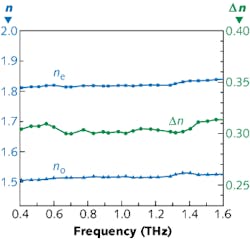Liquid-crystal material has large birefringence for terahertz radiation
Liquid crystals (LCs) are commonly used at visible wavelengths, but it turns out that these materials can be used for optical devices at terahertz frequencies, too. A group at Nanjing University (Nanjing, China) and Tsinghua University (Beijing, China) is using a fluorinated phenyl-tolane-based nematic LC mixture between two thin fused silica plates (rubbed for LC orientation) as a birefringent material for radiation in the 0.4 to 1.6 THz range. The materials have a mean birefringence of 0.306 over that range, reaching a peak at 0.314 at 1.6 THz.
The gap between the two 0.7-mm-thick plates was 0.127 mm, and for testing the assembly was immersed in a nitrogen atmosphere to avoid water vapor absorption. Terahertz time-domain spectroscopy (THz-TDS) was used to characterize the material, with the refractive-index effects of the fused silica itself measured first and then subtracted out from the subsequent data. Both real and imaginary components of the ordinary (no) and extraordinary (ne) refractive indices were measured (the real portion is shown here). The imaginary part of birefringence, which is associated with the absorption coefficient, showed low absorption over the whole testing range. The LC material has potential for fast tunable terahertz optical devices. Contact Xiao Liang at [email protected].

John Wallace | Senior Technical Editor (1998-2022)
John Wallace was with Laser Focus World for nearly 25 years, retiring in late June 2022. He obtained a bachelor's degree in mechanical engineering and physics at Rutgers University and a master's in optical engineering at the University of Rochester. Before becoming an editor, John worked as an engineer at RCA, Exxon, Eastman Kodak, and GCA Corporation.
